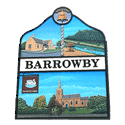Barrowby’s history from prehistory to today
Archaeological evidence indicates that there is a long history of settlement around Barrowby. Prehistoric pottery and flints (including arrowheads, blades and scrapers) have been found, as have Iron Age and Romano-British pottery and occupation evidence. The village probably dates from the late Anglo-Saxon period and the name Barrowby is derived from the Old Norse “berg” and Old Danish “by” which translates as farmstead or village on the hill.
The settlement of Barrowby is first mentioned in the Domesday Book in which the village is referred to as “Bergebi”, thought to derive from Scandinavian languages ‘berg-by’ meaning ‘village by the hill’. It had a sizeable manor held by Robert Malet, including a watermill, a church and 60 acres of meadow. A medieval manor house stood on the site occupied by Barrowby Old Hall which is partially surrounded by the earthwork remains of the moat. There are traces of medieval ridge and furrow fields at several locations. The parish also contains the remains of Casthorpe deserted medieval village and Newbo Abbey, a daughter house of Newsham Abbey, founded in 1198 and dissolved in 1536, was located near the A52.
Barrowby was always an agricultural village. In the 19th century the Duke of Devonshire, who was Lord of the Manor, owned roughly half the parish whilst Sir J.C Thorold owned about one-quarter and this continued up until the early 20th century. The village grew dramatically in size towards Grantham after the 1970s, a trend which continues today.
Two Heritage Walks, exploring the historic core of the village and the environs of the parish, are available to download in the Out and About section of this website here.

